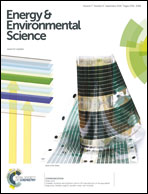Lead-free organic–inorganic tin halide perovskites for photovoltaic applications†
Abstract
Already exhibiting solar to electrical power conversion efficiencies of over 17%, organic–inorganic lead halide perovskite solar cells are one of the most promising emerging contenders in the drive to provide a cheap and clean source of energy. One concern however, is the potential toxicology issue of lead, a key component in the archetypical material. The most likely substitute is tin, which like lead, is also a group 14 metal. While organic–inorganic tin halide perovskites have shown good semiconducting behaviour, the instability of tin in its 2+ oxidation state has thus far proved to be an overwhelming challenge. Here, we report the first completely lead-free, CH3NH3SnI3 perovskite solar cell processed on a mesoporous TiO2 scaffold, reaching efficiencies of over 6% under 1 sun illumination. Remarkably, we achieve open circuit voltages over 0.88 V from a material which has a 1.23 eV band gap.


 Please wait while we load your content...
Please wait while we load your content...